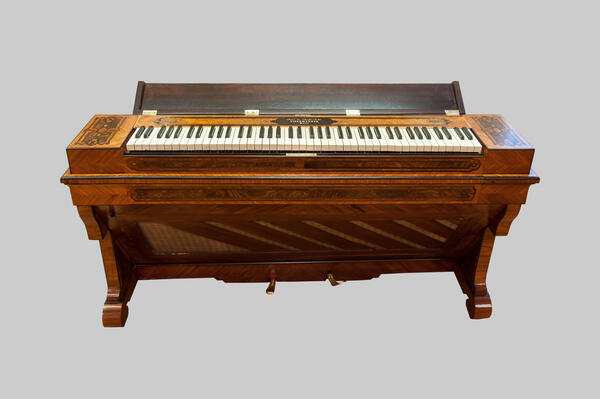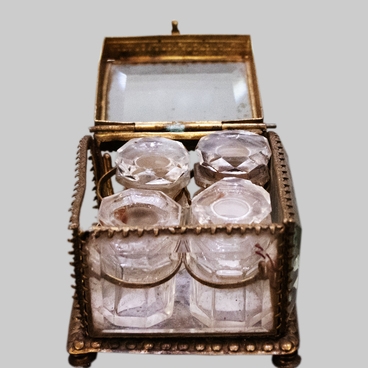French minipiano manufactured at an Eigenmenger Parish factory. This original piece was created by master Michel Eisenmenger in 1855. The work is truly impressive with its small size. The soundboard, which is responsible for the instrument’s sound, is positioned inside the body at an angle, while grand pianos and square pianos have horizontal soundboards, and soundboards in standard modern pianos are vertically-oriented.
The keyboard is situated at the top part of the instrument, while the piano action mechanism, a device consisting of levers, belts, and hammers, is positioned in a way that allows the piano to have strings of the necessary length despite the extremely low height of its body.
By the way, this feature proved to be appealing not only to piano players, but also to their listeners. Being only 80 centimeters in height, this instrument allowed to see both the pianist’s torso and hands during performances.
The piano is finished with walnut with floral intarsia patterns of cherry, pear, and ash veneer.
Intarsia (from Italian intarsio, meaning ‘inlay’) is a kind of decorative art that involves inserting one material into another by ‘cutting’ its pieces in. In this case, it is wood inlaid with wood. This technique is done exclusively by hand and is applied, for instance, in the production of expensive furniture. This is done by selecting pieces of wood of different color, which, after the removal of all defects, are cut into very thin veneer strips. The resulting strips are glued together to form sheets of the desired size that are then cut into mosaic pieces. The elements of the pattern are tightly fitted to each other, glued together, and inserted into pre-cut grooves in the workpiece. The face side of the mosaic is then carefully polished.
Same as inlay, intarsia originated in the Ancient East, in Egypt, and was later perfected in Ancient Greece and Rome, where ornaments were commonly created with the use of maple, boxwood, holly, ironwood, and dogwood.
The keys of this minipiano are covered with bone tops. Traditionally, keys used to be manufactured from ivory. However, increasingly strict bans on ivory poaching led to its replacement – first, with walrus tusks, and then with plastic, which is still used for this purpose to this day.
The keyboard is situated at the top part of the instrument, while the piano action mechanism, a device consisting of levers, belts, and hammers, is positioned in a way that allows the piano to have strings of the necessary length despite the extremely low height of its body.
By the way, this feature proved to be appealing not only to piano players, but also to their listeners. Being only 80 centimeters in height, this instrument allowed to see both the pianist’s torso and hands during performances.
The piano is finished with walnut with floral intarsia patterns of cherry, pear, and ash veneer.
Intarsia (from Italian intarsio, meaning ‘inlay’) is a kind of decorative art that involves inserting one material into another by ‘cutting’ its pieces in. In this case, it is wood inlaid with wood. This technique is done exclusively by hand and is applied, for instance, in the production of expensive furniture. This is done by selecting pieces of wood of different color, which, after the removal of all defects, are cut into very thin veneer strips. The resulting strips are glued together to form sheets of the desired size that are then cut into mosaic pieces. The elements of the pattern are tightly fitted to each other, glued together, and inserted into pre-cut grooves in the workpiece. The face side of the mosaic is then carefully polished.
Same as inlay, intarsia originated in the Ancient East, in Egypt, and was later perfected in Ancient Greece and Rome, where ornaments were commonly created with the use of maple, boxwood, holly, ironwood, and dogwood.
The keys of this minipiano are covered with bone tops. Traditionally, keys used to be manufactured from ivory. However, increasingly strict bans on ivory poaching led to its replacement – first, with walrus tusks, and then with plastic, which is still used for this purpose to this day.



